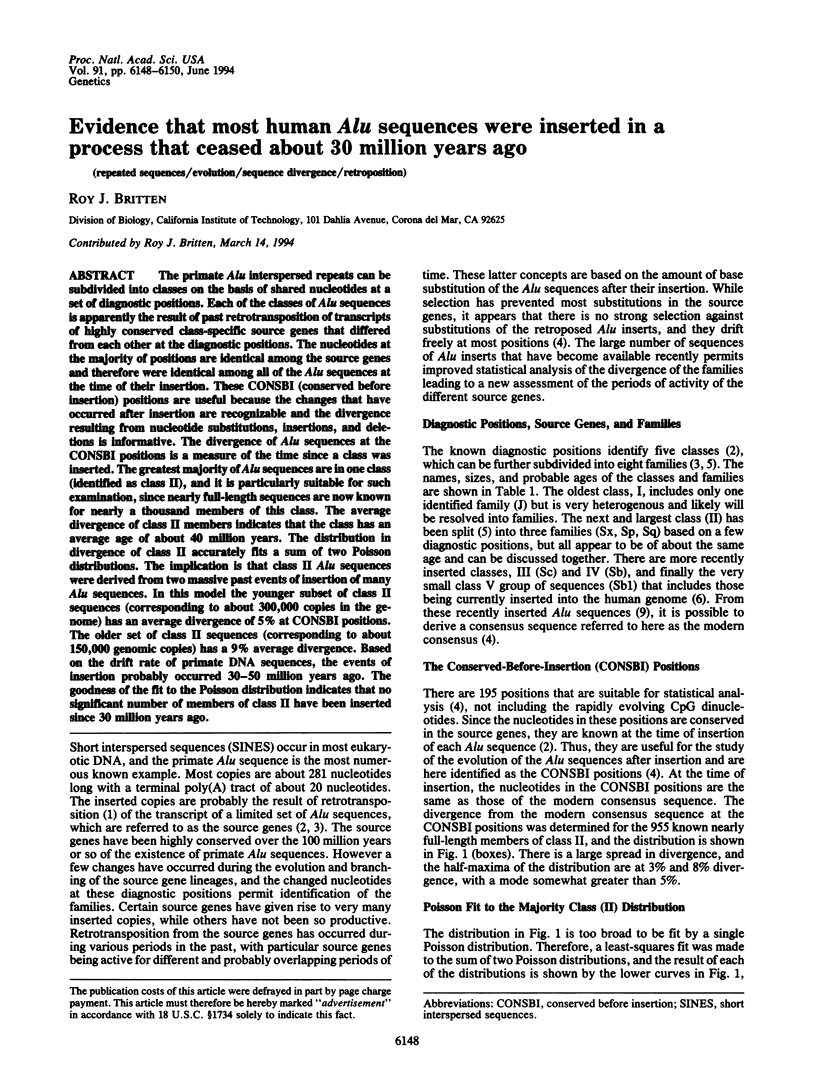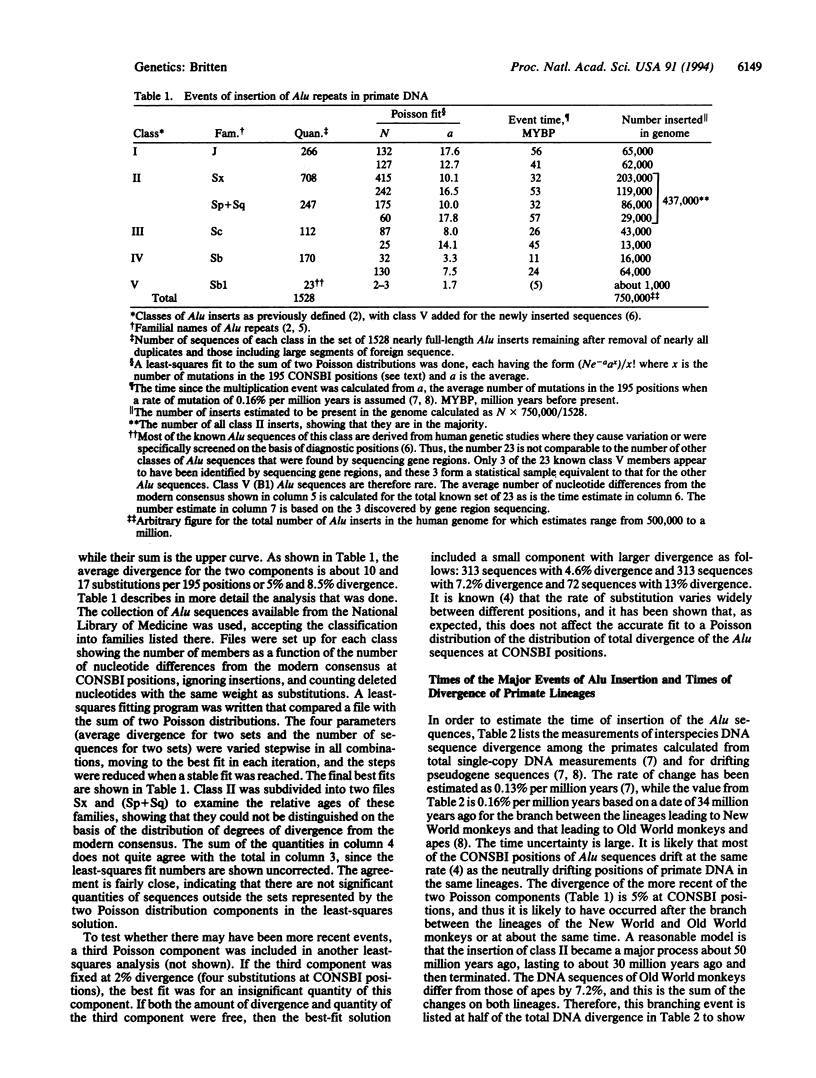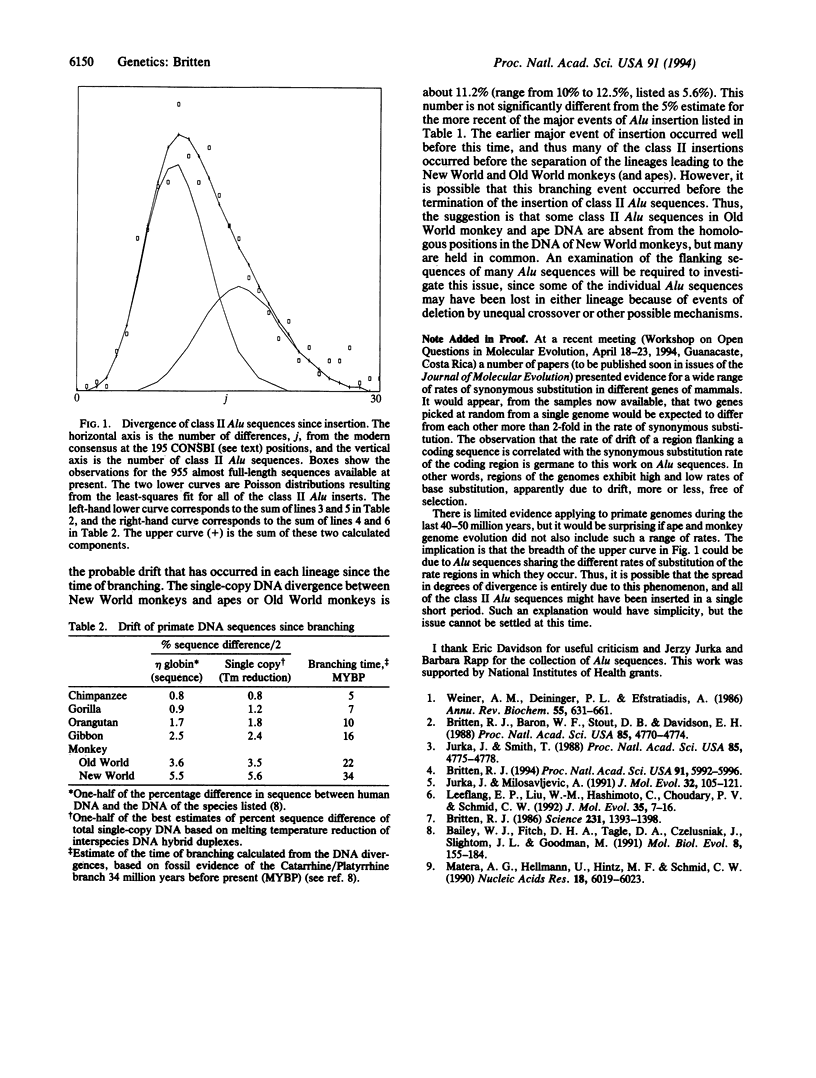Abstract
The primate Alu interspersed repeats can be subdivided into classes on the basis of shared nucleotides at a set of diagnostic positions. Each of the classes of Alu sequences is apparently the result of past retrotransposition of transcripts of highly conserved class-specific source genes that differed from each other at the diagnostic positions. The nucleotides at the majority of positions are identical among the source genes and therefore were identical among all of the Alu sequences at the time of their insertion. These CONSBI (conserved before insertion) positions are useful because the changes that have occurred after insertion are recognizable and the divergence resulting from nucleotide substitutions, insertions, and deletions is informative. The divergence of Alu sequences at the CONSBI positions is a measure of the time since a class was inserted. The greatest majority of Alu sequences are in one class (identified as class II), and it is particularly suitable for such examination, since nearly full-length sequences are now known for nearly a thousand members of this class. The average divergence of class II members indicates that the class has an average age of about 40 million years. The distribution in divergence of class II accurately fits a sum of two Poisson distributions. The implication is that class II Alu sequences were derived from two massive past events of insertion of many Alu sequences. In this model the younger subset of class II sequences (corresponding to about 300,000 copies in the genome) has an average divergence of 5% at CONSBI positions. The older set of class II sequences (corresponding to about 150,000 genomic copies) has a 9% average divergence. Based on the drift rate of primate DNA sequences, the events of insertion probably occurred 30-50 million years ago. The goodness of the fit to the Poisson distribution indicates that no significant number of members of class II have been inserted since 30 million years ago.
Full text
PDF


Selected References
These references are in PubMed. This may not be the complete list of references from this article.
- Bailey W. J., Fitch D. H., Tagle D. A., Czelusniak J., Slightom J. L., Goodman M. Molecular evolution of the psi eta-globin gene locus: gibbon phylogeny and the hominoid slowdown. Mol Biol Evol. 1991 Mar;8(2):155–184. doi: 10.1093/oxfordjournals.molbev.a040641. [DOI] [PubMed] [Google Scholar]
- Britten R. J., Baron W. F., Stout D. B., Davidson E. H. Sources and evolution of human Alu repeated sequences. Proc Natl Acad Sci U S A. 1988 Jul;85(13):4770–4774. doi: 10.1073/pnas.85.13.4770. [DOI] [PMC free article] [PubMed] [Google Scholar]
- Britten R. J. Evolutionary selection against change in many Alu repeat sequences interspersed through primate genomes. Proc Natl Acad Sci U S A. 1994 Jun 21;91(13):5992–5996. doi: 10.1073/pnas.91.13.5992. [DOI] [PMC free article] [PubMed] [Google Scholar]
- Britten R. J. Rates of DNA sequence evolution differ between taxonomic groups. Science. 1986 Mar 21;231(4744):1393–1398. doi: 10.1126/science.3082006. [DOI] [PubMed] [Google Scholar]
- Jurka J., Milosavljevic A. Reconstruction and analysis of human Alu genes. J Mol Evol. 1991 Feb;32(2):105–121. doi: 10.1007/BF02515383. [DOI] [PubMed] [Google Scholar]
- Jurka J., Smith T. A fundamental division in the Alu family of repeated sequences. Proc Natl Acad Sci U S A. 1988 Jul;85(13):4775–4778. doi: 10.1073/pnas.85.13.4775. [DOI] [PMC free article] [PubMed] [Google Scholar]
- Leeflang E. P., Liu W. M., Hashimoto C., Choudary P. V., Schmid C. W. Phylogenetic evidence for multiple Alu source genes. J Mol Evol. 1992 Jul;35(1):7–16. doi: 10.1007/BF00160256. [DOI] [PubMed] [Google Scholar]
- Matera A. G., Hellmann U., Hintz M. F., Schmid C. W. Recently transposed Alu repeats result from multiple source genes. Nucleic Acids Res. 1990 Oct 25;18(20):6019–6023. doi: 10.1093/nar/18.20.6019. [DOI] [PMC free article] [PubMed] [Google Scholar]
- Weiner A. M., Deininger P. L., Efstratiadis A. Nonviral retroposons: genes, pseudogenes, and transposable elements generated by the reverse flow of genetic information. Annu Rev Biochem. 1986;55:631–661. doi: 10.1146/annurev.bi.55.070186.003215. [DOI] [PubMed] [Google Scholar]


